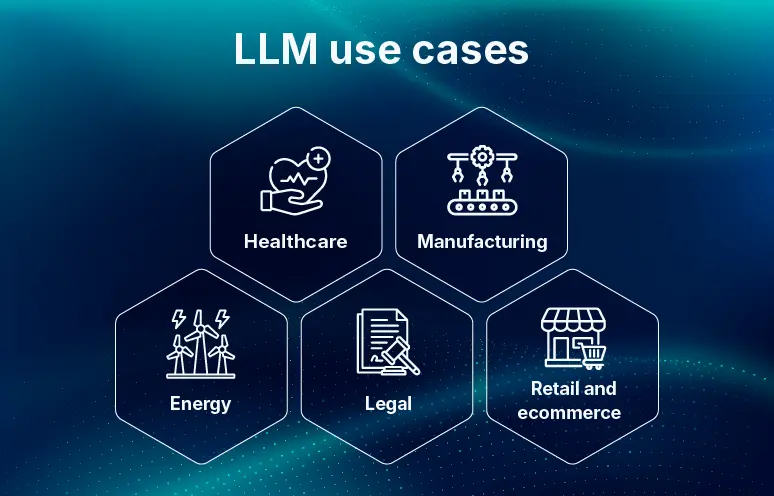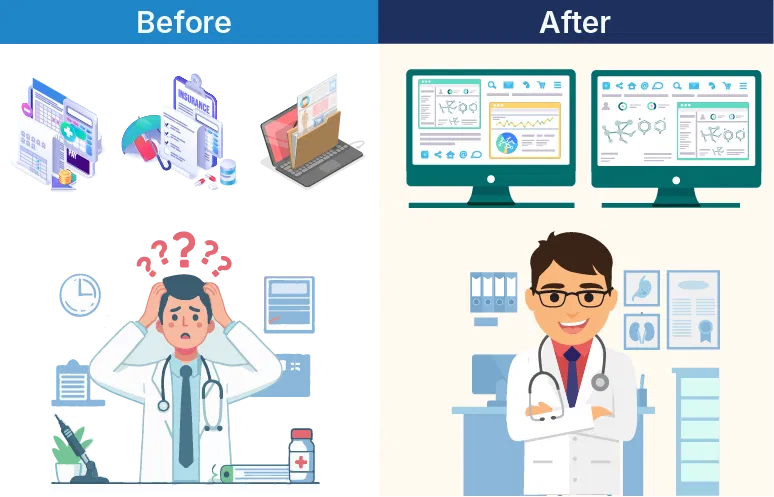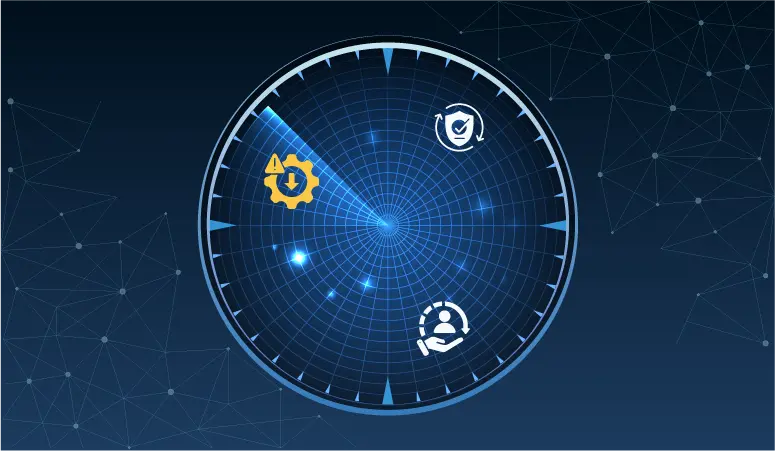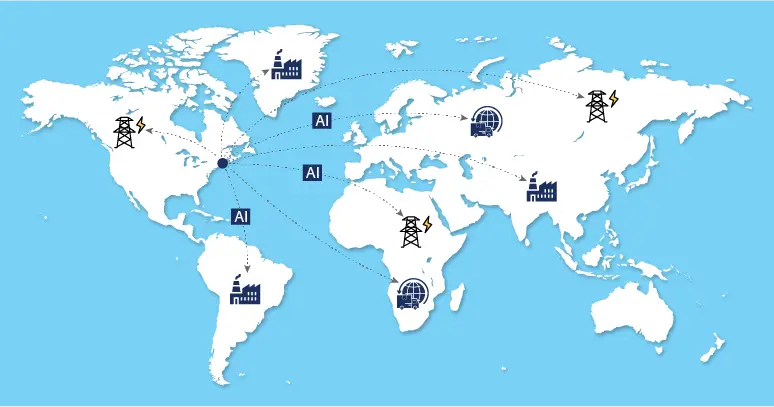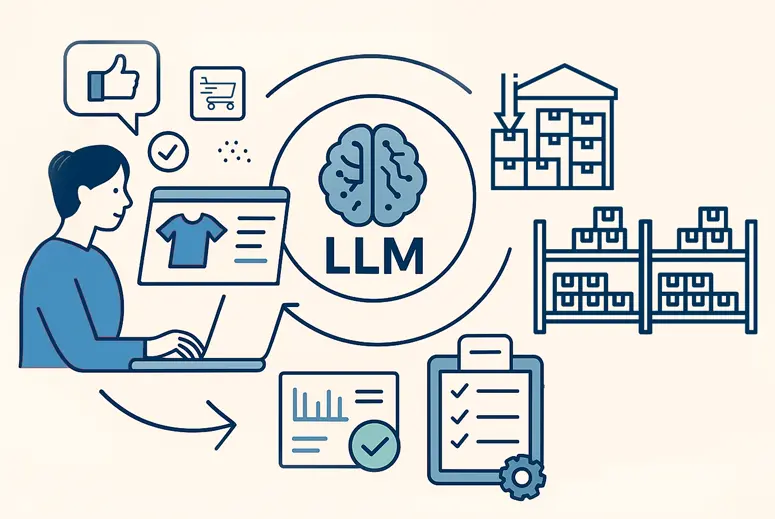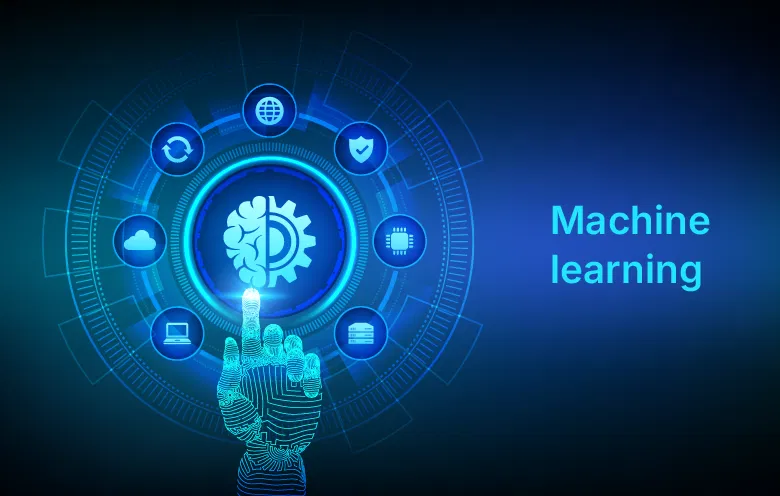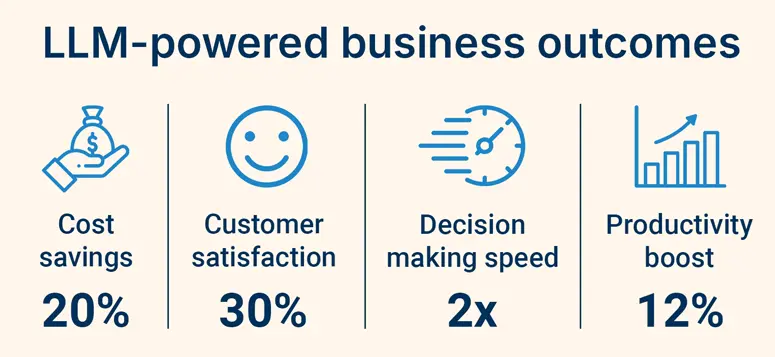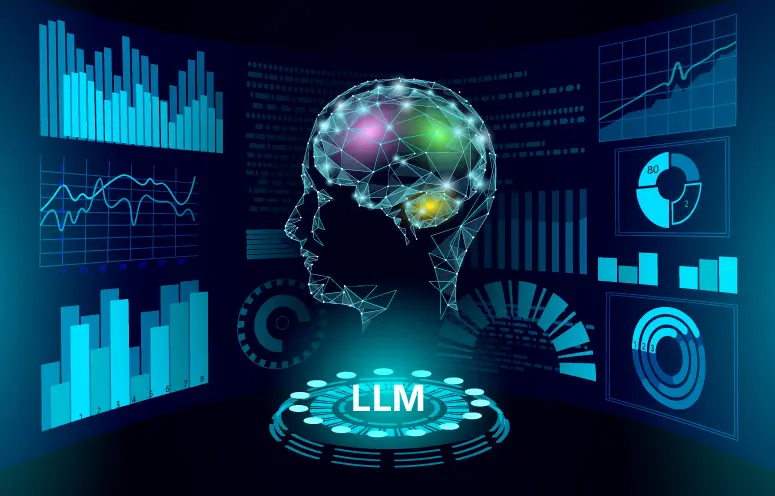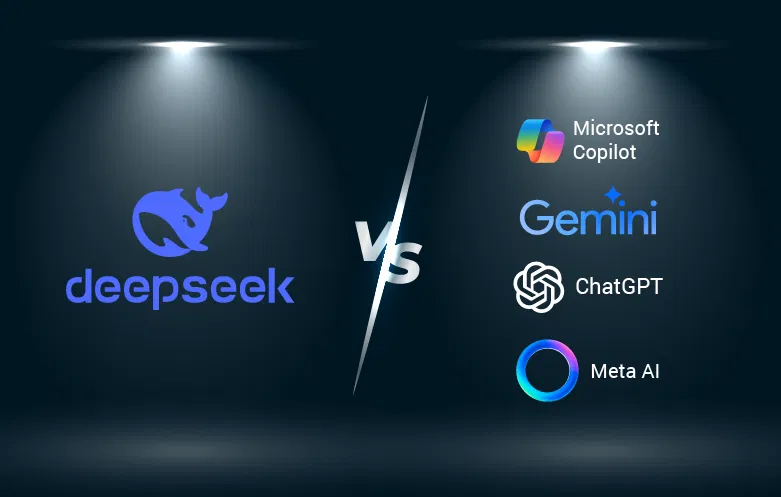2025 marks a turning point in the adoption of Large Language Models (LLMs) in the business world. Enterprises are rapidly integrating LLMs into their workflows, governance structures, and decision systems. McKinsey Technology Trends Outlook 2025 reports that the use of generative AI systems powered by LLMs across businesses jumped from 33% to 67% in 2025.
Using LLM development services, companies are realizing tangible benefits, with examples like JPMorgan Chase reducing fraud, Walmart optimizing inventory, UnitedHealth automating claims, and FedEx enhancing delivery times.
This shift has come from advances in how LLMs are built and applied:
- Sparse transformers and quantum AI integration help reduce the resources
- Retrieval-Augmented Generation (RAG) technique improves context retention ability
- Multimodal AI capabilities allow models to handle text, images, audio, and video together
- Autonomous AI agents provide LLMs the ability to make independent decisions
Building on these advancements, the development of industry-specific LLMs is also accelerating. For instance, BloombergGPT has been created for finance and Med-PaLM for healthcare. They are designed to make LLMs more usable and effective within specialized fields.
This blog post delves into LLM use cases that are shaping enterprise performance. We will explore how businesses align LLM capabilities with their core objectives. They adopt LLMs to optimize customer experiences and upgrade internal operations that impact performance.
What are Large Language Models (LLMs)?
LLMs are a type of Artificial Intelligence (AI) that can understand, generate, and manipulate human language. They use deep learning algorithms, specifically the transformer architecture, and are trained on massive datasets of text and code. They perform tasks like translation, summarization, and code generation.
The functioning of an LLM involves the following three stages:
- Tokenization: It converts text into numerical representations called “tokens” that the model can process. A token can represent a word, subword, or character.
- Training: The model is trained on a wide range of text. Using a self-attention mechanism of the transformer architecture, the model learns word importance, context, and semantics. LLM adjusts its parameters to predict the next word in a sentence.
- Inference: LLMs adjust internal parameters to predict the most probable sequence of words. That produces clear and contextually relevant output.
Below are common applications of LLMs:
- Content generation
- Code generation
- Summarization
- Translation
- Sentiment analysis
- Information retrieval
- Document classification
- Image and speech analysis
Top LLM use cases across industries
LLM use cases have a high impact across enterprises in every sector. They reduce costs, improve decision quality, and increase operational efficiency by applying LLMs. While the applications of LLMs differ across industries, the outcome remains consistent: tangible business value.
LLM use cases in healthcare
LLMs are transforming healthcare by addressing the sector’s challenges of rising costs, improving patient outcomes, and maintaining compliance. By using LLMs, healthcare organizations report notable improvements in efficiency and accuracy.
Here’s how the healthcare industry uses LLMs:
1. Boosts diagnostic accuracy and speed
Analyzing medical information, such as lab results, clinical notes, and patient history is time taking for doctors. LLMs can process this medical information and present potential diagnoses alongside relevant clinical evidence.
For instance:
- IBM Watson for Oncology analyzes patient data against oncology literature to recommend treatment options with evidence. It processes thousands of research articles and clinical guidelines to help physicians make decisions.
2. Streamlines administrative workflows
LLMs can assist healthcare organizations by automating appointment scheduling, sending follow-up reminders, updating patient records, and processing billing or insurance claims. Such automation can help healthcare organizations cut errors, speed up reimbursements, and improve patient engagement.
3. Personalizing patient care and engagement
LLMs offer a path toward more personalized care. LLMs can:
- Give patients easy access to health information
- Provide personalized advice based on a patient’s medical history
- Explain a diagnosis and treatment options in simple terms
LLMs can provide 24/7 support to patients. Additionally, they can offer mental health assistance, which can improve patient engagement and satisfaction.
Blog
Machine learning in healthcare: Use cases, benefits, and real-world examples

LLM use cases in finance
LLMs can help financial institutions to stay competitive by improving their risk management, ensuring regulatory compliance, and serving customers better. They can quickly review financial documents, find unusual financial activities, and provide personalized investment advice. The finance industry benefits from faster operations, while delivering a more seamless and intuitive customer journey.
Here are top three LLM use cases in finance:
1. Fraud detection and risk assessment
As fraudsters get better at what they do, it’s not easy to catch them with old methods like manual bookkeeping or physical transaction verification. LLMs can analyze large volumes of data, including transaction details, communication records, and how people act, to find suspicious activity in real-time. The ability to learn and adapt keeps banks ahead of evolving fraud schemes.
Such as:
- JPMorganChase uses a system called COIN (Contract Intelligence) to analyze legal documents for signs of fraud. This system processes thousands of documents daily and alerts human reviewers to any unusual patterns much faster and more accurately than manual processes.
- Wells Fargo uses ML-powered FICO solutions for protection from fraudulent activities.
- Bank of America uses LLM-based risk assessment models to assess credit risk accurately and lower default rates and bad debt.
2. Smart investment decisions
Making smart investment choices requires looking at a wide range of data, such as market trends, economic indicators, and company financial reports. LLMs can process this massive amount of information quickly, helping professionals get insights and make more informed decisions about managing investments.
To cite an instance:
- BlackRock uses LLMs in its Aladdin platform to analyze market trends and calculate risk for portfolios worldwide. This system studies earnings calls, analyst reports, and other economic data to give investment advice. BlackRock manages $10 trillion in assets and relies on these AI systems to go through thousands of data points daily.
3. Personalized customer service
Banks use LLMs to give customers personalized advice. They look at a customer’s spending patterns, income data, and financial goals through their apps and websites.
For instance:
- Bank of America’s virtual assistant, Erica, changes how customers manage their money. They use LLMs to handle over one billion customer interactions a year, providing personalized financial tips and helping with transactions.
The bottom line is that LLMs make banks more efficient, more secure, and better for their customers in a fast-changing market.
LLM use cases in manufacturing
Machines, sensors, and quality checks of any manufacturing plant generate massive data. LLMs can process this data and help manufacturers to cut costs and run operations smoothly.
Key areas where LLMs are making an impact in manufacturing:
1. Predictive maintenance
Unexpected machine breakdown incurs high repair costs and production delays. LLMs can review sensor data, past maintenance records, and operating patterns to flag problems. This approach minimizes unexpected downtime, reduces emergency repair costs, and extends equipment life.
For instance:
- General Electric‘s Predix platform uses LLMs to review maintenance reports. The platform helps find warning signs and schedule preventive repairs. Predix connects machines, data, and analytics to keep GE’s operations running efficiently.
2. Streamlines production and improves quality
Product quality, energy use, and overall output depend on varied factors in manufacturing. LLMs can study production data and suggest ways to run processes smoothly. Manufacturers benefit from higher-quality products, less waste, and greater efficiency.
3. Enhances supply chain visibility and manages risks
Manufacturing depends on supply chains with many suppliers, logistics partners, and regional regulations. With so many moving parts, it is not easy to track everything and prepare for risks. LLMs can help manufacturers by reviewing shipping records, supplier messages, and market updates to identify possible supply chain disruptions early.
For example:
- Amazon uses LLMs to manage their warehouses and predict what customers will buy. LLMs process millions of data points daily and help Amazon to keep just the right amount of stock, lower storage costs and get orders to people faster.
LLM use cases in energy
The energy industry is highly complex, dealing with strict rules, large volumes of technical documents, and constant research and development across various locations. LLMs help energy companies manage all this complexity, boosting efficiency and ensuring they meet demanding standards.
Here’s how the energy sector uses LLMs:
1. Manages technical documents and staying compliant
Energy projects produce vast amounts of documents, like reports on drilling, safety protocols, and environmental studies. LLMs can scan through them quickly, highlight important details, and flag compliance risks. That makes the review process faster and more reliable.
For instance:
- Shell applies LLMs to analyze reports and safety documents across its global operations. This helps Shell stay compliant and maintain high safety standards.
2. Powers research and innovation
Researchers need to go through technical papers, patent filings, and industry reports to find new developments and market opportunities. LLMs can speed up this process, making it easier for researchers to get the main takeaways and explore new ideas.
For example:
- ExxonMobil uses LLMs to analyze scientific papers and identify research areas in renewables and carbon capture technology. This helps them stay ahead of the curve.
3. Fuels customer service and efficiency
LLMs can improve customer support for energy efficiency programs. LLMs can help specialists find information more quickly, respond to customer questions, and handle routine customer-facing administrative tasks. It leads to faster service and better customer satisfaction.
What energy companies gain with LLMs
- Manage large volumes of documents efficiently
- Increase safety and stay compliant with regulations
- Develop new technologies and innovate faster
- Provide more personalized customer support for energy-saving programs
LLM use cases in legal
Legal professionals face the demanding task of going through piles of legal documents, like court rulings, contracts, and regulations. They have to do this quickly and accurately. LLMs can help by making document review, legal research, and keeping up with compliance much faster and easier, all while maintaining high standards. Law firms and in-house legal departments are seeing a boost in productivity by using smart AI to handle many routine tasks.
Key areas where LLMs are making a difference:
1. Analyzes contracts and spots risks
Legal teams review a large volume of contracts each month to find potential risks, unusual terms, or compliance issues. LLM tools are designed to analyze contract language and compare it against industry standards and legal requirements, according to the user message.
These tools can:
- Automatically find unusual or missing terms
- Score contracts based on their complexity and non-standard clauses
- Check contracts against industry regulations and company policies
- Compare contracts to similar agreements and market standards
LLM tools help lawyers complete contract reviews much faster and more accurately than doing it manually, according to the user message.
2. Streamlines legal research and case analysis
Lawyers spend significant time researching past court decisions and legal opinions to build strong arguments and legal strategies for their clients. Tools like Westlaw Edge now use AI to analyze court decisions and suggest relevant cases based on specific legal issues and jurisdiction.
LLM-powered tools improve legal research by:
- Significantly reducing the time needed for complex legal research
- Accurately ranking how relevant different cases are
- Automatically checking citations and validating legal precedents
- Providing comprehensive coverage of court systems
In essence, LLMs are serving as powerful assistants, making legal work more efficient, accurate, and ultimately, more effective.
LLM use cases in retail and ecommerce
The retail world thrives on giving customers personalized experiences, managing inventory efficiently, and offering competitive prices. LLMs help retailers achieve these goals by analyzing shopper behavior, predicting customer needs, and making it easier for people to find products through smart search features. This means retailers can increase sales and reduce operational costs by automating processes based on real-time data insights.
Key areas where LLMs are making a difference:
1. Creates personalized shopping experiences
Online shoppers want product recommendations that feel like a knowledgeable salesperson is serving them. LLMs make this possible by analyzing customer browsing habits, past purchases, and even how similar shoppers behave to suggest products. Amazon’s recommendation engine is a prime example of this, using LLMs to personalize recommendations and descriptions. It analyzes attributes of products, along with customer data, like preferences, search, browsing, and purchase history, to deliver personalized suggestions.
Personalization drives significant business impact:
- It leads to higher average order values as customers are more likely to buy recommended products that match their needs.
- It also improves customer retention rates because shoppers feel understood and valued, according to the user message.
- Conversions increase when product pages are tailored to individual preferences, notes the user message.
- LLMs help customers discover the right products by making search functions more intuitive and context aware.
2. Optimizes inventory and predicting demand
Retailers with inventory have enough stock to meet demand without having too much on hand, which can be costly. LLMs help by analyzing vast datasets to forecast demand more accurately and manage inventory levels effectively.
For instance:
- Walmart‘s use of machine learning algorithms to forecast demand and optimize inventory is an excellent example of this. They analyze sales data from thousands of stores, considering factors like local market conditions, seasonal trends, and promotional activities.
- Walmart’s approach minimizes inventory carrying costs and reduces stockouts, especially for high-demand products.
By using LLMs for personalized recommendations, intelligent search, and optimized inventory, retailers can create more engaging shopping experiences, reduce costs, and ultimately increase sales and customer satisfaction.
Key benefits of LLM for enterprises
LLMs transform how businesses operate and gain a competitive edge. Companies that strategically implement LLMs are seeing faster decision-making, happier customers, and significant cost savings across their operations. By embracing LLMs, businesses can innovate more quickly and respond to market changes with greater agility. Here’s how LLMs are creating real value for businesses:
-
Reduce costs and boost efficiency
LLMs can take over many tasks that involve a lot of reading, writing, and understanding language, traditionally requiring significant human time and effort. By automating tasks such as handling customer inquiries, processing documents, and analyzing data, businesses can significantly reduce their operating expenses and improve overall efficiency. Companies are reporting substantial savings through strategic LLM implementation across customer service, document processing, and data analysis functions.
-
Make smarter decisions
Business leaders are now able to get a much clearer picture of what’s happening by using LLM-powered systems. These systems can analyze vast amounts of information from different sources simultaneously, including market data, operational details, and customer feedback. This means executives can make more informed decisions much faster and with a broader understanding of the situation than they could with traditional manual analysis.
-
Deliver exceptional customer experiences
LLM-powered systems can handle a huge number of customer interactions all at once without compromising service quality, even during busy periods. This helps customer service teams consistently provide high-quality responses while drastically reducing wait times. Companies see improved customer satisfaction and manage their support resources more effectively through this smart automation.
-
Gain a competitive edge
Businesses that adopt LLMs early are getting a head start on their competition. By making their operations more efficient and offering innovative customer experiences that are difficult for competitors to copy, they establish a strong position in the market. LLMs empower market leaders to react more quickly to threats and maintain a high level of operational excellence.
LLMs are not just about working faster or at lower cost. They help businesses make better decisions, keep customers happy, and stay ahead in a rapidly changing world.
Real-world LLM success stories in business
Organizations are deploying LLMs across industries to achieve measurable results. These initiatives target high-value business processes, delivering productivity gains, cost savings, and stronger competitive positions.
Here are some examples of how leading organizations are successfully using LLMs today:
-
Transforming customer service
- Klarna: Automated customer support
Klarna, a global fintech company, has implemented an AI assistant powered by LLMs to handle customer service interactions. The system manages millions of conversations monthly, significantly reducing the workload for human agents while maintaining high customer satisfaction levels. According to a Google Cloud report, Klarna reports substantial annual savings through this automated approach. Available 24/7 across multiple markets and languages, the LLM-powered assistant ensures consistent and efficient support for a vast customer base.
- Octopus Energy: Enhanced customer support
Octopus Energy, a leading energy provider, has also seen remarkable success with LLM-powered customer service. They use generative AI to manage email responses and provide automated support for various customer inquiries, such as billing questions and service requests. This has led to improved customer satisfaction, with AI-assisted emails achieving a higher satisfaction rate than human-only responses. Octopus Energy has significantly reduced customer service costs and improved response times through this approach.
-
Revolutionizing financial advisory and research
- Morgan Stanley: Smarter investment research
Morgan Stanley has deployed LLMs to analyze extensive research reports and market intelligence for their financial advisors. This system processes a vast amount of research daily, generating personalized investment insights based on client profiles and market conditions. Financial advisors can quickly access comprehensive research analysis in minutes rather than hours, enhancing the quality of client consultations and speeding up decision-making.
-
Personalizing learning experiences
- Duolingo: Personalized language learning
Duolingo utilizes LLMs to create personalized learning experiences for its millions of users across many languages. The system adapts lesson difficulty, provides context-specific explanations, and generates practice exercises tailored to individual learning patterns. This personalized approach leads to better learning outcomes for students. According to Apparently AI, Duolingo uses LLMs to create lesson content, allowing human experts to focus on outlining the curriculum and exercise types.
-
Boosting developer productivity
- GitHub Copilot: AI-powered code assistance
GitHub Copilot, developed in collaboration with OpenAI, uses LLMs to provide intelligent code suggestions and autocompletion, which enhances coding efficiency and reduces development time.
- Mercado Libre: Handling technical queries
Mercado Libre developed an internal LLM-powered tool to answer technical questions and automate documentation creation, trained on internal company data.
-
Optimizing internal business operations
- Instacart: Internal AI assistant (Ava)
Instacart’s internal AI assistant, Ava, powered by LLMs, is used across departments like engineering and marketing for tasks such as code generation, meeting summaries, and drafting communications.
- RBC (Royal Bank of Canada): Internal Knowledge Management (Arcane)
RBC’s Arcane system uses LLMs with Retrieval-Augmented Generation (RAG) to help employees find and summarize information from internal policies via a chatbot.
These examples demonstrate the tangible benefits of LLMs across different industries, improving efficiency, reducing costs, enhancing customer experiences, and driving innovation.
Making LLMs work for your business
To truly capitalize on LLM capabilities and secure a competitive advantage, a structured approach is essential. This involves strategic planning, meticulous execution, and ongoing optimization, ensuring LLMs are aligned with your business goals.
The most impactful LLM implementations focus on augmenting human capabilities rather than replacing expertise. Building a robust, scalable architecture is critical to supporting these transformative solutions, ensuring they adapt and perform optimally as your business evolves.
To navigate the complexities of LLM deployment and achieve measurable business results, collaborating with experienced development partners is key. Look for partners who understand your industry’s nuances and have a proven track record in delivering high-performance, secure, and scalable solutions. Let us help you turn your vision into a powerful reality that drives innovation, efficiency, and sustained market leadership.
Frequently asked questions
1. What are examples of LLMs?
Enterprise-ready LLMs include GPT-4 from OpenAI, Claude by Anthropic, and IBM Watson Health. They support use cases such as customer service automation, financial analysis, healthcare support, and legal research. Success depends on selecting the right use case and smooth integration.
2. What is the difference between Generative AI and LLMs?
Generative AI creates new content across text, images, audio, and video. LLMs are a subset that focus on language tasks like text generation and processing. All LLMs are generative AI, but not all generative AI models are LLMs.
3. How are LLMs integrated into business operations?
LLMs are integrated via APIs, custom development, or enterprise platforms that connect to existing systems. APIs act as translators between applications and the model. Integration also requires effective change management to align people and processes.
4. What are the challenges in implementing LLMs?
Challenges include safeguarding sensitive data, bridging legacy systems, and mitigating bias in training data. LLMs can also produce incorrect outputs, requiring strong validation. Professional implementation partners help reduce risks with tested approaches.
5. How do Large Language Models (LLMs) work?
LLMs use transformer-based neural networks trained on massive datasets. They analyze text, identify context, and generate relevant responses by predicting word sequences. This ability enables a wide range of language-focused tasks at scale.
